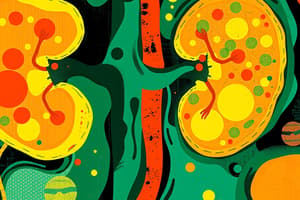Podcast
Questions and Answers
What is the daily urine volume range that indicates normal urination?
What is the daily urine volume range that indicates normal urination?
1 -- 2 L.
What does the presence of pus in urine indicate?
What does the presence of pus in urine indicate?
Pyuria.
What is the shape of calcium oxalate crystals?
What is the shape of calcium oxalate crystals?
Envelope.
In cases of oliguria, what is the urine volume threshold per day?
In cases of oliguria, what is the urine volume threshold per day?
What does chyluria indicate the presence of in urine?
What does chyluria indicate the presence of in urine?
What are the physiological causes of polyuria?
What are the physiological causes of polyuria?
What is Beer's Law?
What is Beer's Law?
What are the pathological causes of oliguria?
What are the pathological causes of oliguria?
List two uses of a centrifuge.
List two uses of a centrifuge.
At what wavelength is serum glucose concentration measured in the colorimetric determination method?
At what wavelength is serum glucose concentration measured in the colorimetric determination method?
Flashcards
Oliguria
Oliguria
Low urine volume, less than 500 ml per day.
Polyuria
Polyuria
Increased urine volume, more than 2 L per day.
Pyuria
Pyuria
The presence of pus in the urine.
Chyluria
Chyluria
Signup and view all the flashcards
Cystine Crystals
Cystine Crystals
Signup and view all the flashcards
Gout
Gout
Signup and view all the flashcards
Specific gravity of urine
Specific gravity of urine
Signup and view all the flashcards
Centrifugation
Centrifugation
Signup and view all the flashcards
Beer's Law
Beer's Law
Signup and view all the flashcards
Spectrophotometry
Spectrophotometry
Signup and view all the flashcards
Study Notes
Physical Properties of Urine
- Normal urine volume per day is 1.5-2.5 liters
- Oliguria is urine volume less than 500 ml per day
- Polyuria is urine volume greater than 2 liters per day
- Causes of polyuria include diabetes mellitus, diabetes insipidus, and increased fluid intake
- Causes of oliguria include dehydration, urinary obstruction, and heart failure
- Normal urine color is pale yellow
- Red urine can be due to hematuria
- Black urine can be due to alkaptonuria
- Chyluria indicates fat in urine
- Pyuria indicates pus in urine
- Calcium oxalate crystals have a rectangular plate shape with notched corners
Chemical Composition of Urine
- Albumin is not a non-protein nitrogenous compound
- Urea levels increase with increased protein catabolism
- Creatinine is a byproduct of creatinine catabolism
- Uric acid is a byproduct of purine catabolism
- Urinary ammonia is elevated in acidosis and cystitis, but decreased in severe nephritis
Studying That Suits You
Use AI to generate personalized quizzes and flashcards to suit your learning preferences.
Related Documents
Description
Explore the essential physical and chemical properties of urine, including normal volume ranges, common abnormalities, and the effects of various conditions. This quiz covers key concepts such as oliguria, polyuria, and the chemical composition of urine constituents. Test your knowledge on this vital aspect of human physiology.




